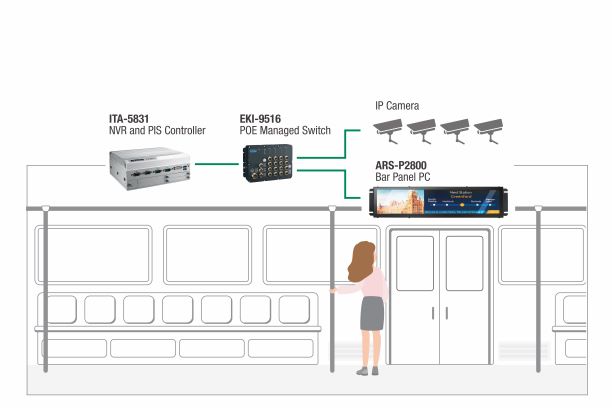Intelligent Solution for Australian Intercity Railway Trains
Project Introduction
Advancements in information and communications technology (ICT) have facilitated the introduction of network and digitized applications in the rail transit industry. For intercity railways, the establishment of passenger information systems (PIS) and CCTV image monitoring systems through ICT products provides passengers with sufficient ride information and a safe ride environment. However, the key to smooth operation of the two systems is the quality of selected hardware products.
Since rail trains are mobile vehicles, electronic products embedded in the vehicle body must not only withstand environmental tests such as vibration, shock, and temperature changes, but also process large amounts of signal and image data. If products with poor specifications and/or insufficient performance are used, there will be delays displaying information, overheating of the car body, problems starting when the weather is too cold, and sudden disconnections for no reason. Train manufacturers must painstakingly solve these problems or operators will receive negative feedback due to poor services.
Advantech provides on-board controllers and managed Ethernet switches certified by international rail transit standards for PIS and video surveillance systems. The devices provide a reliable hardware platform and network connection quality for the demanding environments of rolling stock applications—laying a strong foundation for train manufacturers in new system development and providing operators with a stable operating system.
System Requirements
Australia's New South Wales Railway is a passenger train operating in the outer suburbs and on intercity lines. Recently, the railway operation company launched a tender. The plan was to replace old trains that had been in service for many years. The target date for project completion was 2022. The railway operation company hoped to facilitate management and maintenance through new technology while improving the service quality of intercity railway trains through instant information updates and real-time safety monitoring.
The contractor who obtained this bid was responsible for providing control and management systems for the train—which included the development of the PIS and CCTV systems. The systems had to provide passengers with ride information and a route map, as well as remote cabin monitoring, to serve as evidence. The contractor had to purchase vehicle controllers and network switches to control multiple door displays and the network surveillance cameras (IPcam) installed in the cabin.
The two pieces of hardware required by the contractor had to be internationally certified and compatible with the existing railway environment. Moreover, the on-board controllers had to be small-sized embedded computers with a height of no more than 90mm to be installed in the vehicle body; rugged and durable to ensure stable system operation; and capable of issuing commands to adjust the backlight function of the PIS display so that passengers could clearly perceive ride information without interference from the cabin environment and glare. The network switch had to be a network management product and provided PoE (Power over Ethernet) functionality to power multiple connected IPcams without extra cabling.
System Overview
Advantech's solution, which combined the fanless system ITA-5831 with the managed Ethernet switch EKI-9516P, passed the anti-vibration, anti-shock, and working temperature (-40°C - 70°C) requirements for the railway application standard EN 50155. It also provided a stable operation on-board control platform.
According to the body structure of the new train, the plan called for the installation of three ITA-5831s in each car, in which, two were responsible for the PIS, which was connected to the strip displays through DVI-I ports and adopted a dual-host automatic backup mechanism. When one of the hosts failed, the system automatically enabled the backup host—thereby ensuring the car screen always displayed the latest information. The third ITA-5831 was responsible for the video surveillance system, which connected four IPcams via the EKI-9516P.
The project operated as follows: the server of the train control management system (TCMS) or the traffic control center transmitted ride information to the ITA-5831 via the network and then to each display through the display distributor. The route map and station information could be synchronized on all screens. For IPcams, the images taken were transmitted to the ITA-5831 of each car and stored on the hard disk. The images were simultaneously transmitted so that the driver could see inside the cabins to ensure passenger ride safety.
The most critical product in the solution was the ITA-5831. This high-end processor control platform not only offered the ability to quickly process large amounts of data, but also featured a compact size (220 x 88 x 198.8 mm) ideal for applications with limited space. The fanless, wide temperature range for different applications, IP40/IP50 dustproof rating, M12 locking connectors, and other key design features ensured this embedded computer met the strict requirements for railway applications while delivering a cost-effective solution.
The project used the RS-485 serial port of the ITA-5831 to receive the backlight parameters of the display, notify the train driver when screen brightness in the cars had been automatically adjusted according to the ambient light, and provided information about whether the display worked properly through the return parameters. The ITA-5831 offered different power input (24, 48, 72, 110 VDC) options to meet the voltage requirements of different vehicle types.
The PoE power supply provided by the management-type Ethernet switch (EKI-9516P) allowed the project to avoid laying individual power cables for each IPcam. This simplified the installation and deployment process and saved on construction costs. The EKI-9516P also provided an M12 connector that delivered a tight and secure connection to protect network transmission quality from the vibrations generated by the train or the impact of braking.
Project Induction
ITA-5831: Fanless system with built-in Intel® 6th generation Core™-i processor that met EN 50155 rail application standard
EKI-9516P: 16G managed Ethernet switch with 12 PoE ports that met EN 50155 and IP67 protection
System Diagram

Conclusion
PIS and video surveillance systems are essential infrastructure for modern railway vehicles. As the control core of the two systems, embedded computers and network switches lacking in quality testing place the system at risk of ineffective operation.
Advantech's in-vehicle control solution passed strict quality control testing in terms of performance, size, operating temperature, vibration, shock, and dust resistance. In addition to high product quality, Advantech's technical team offers considerable professional competence in rail applications. We solve software and hardware integration problems for train contractors in this and other projects

